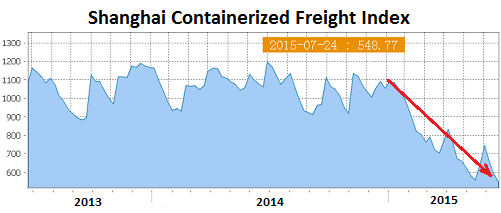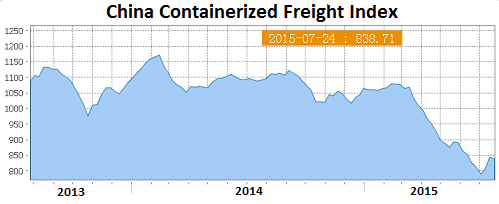One of the indicators that show that things are not all that rosy in China, or in the global economy, is the price carriers charge to ship containers from China to its big trading partners around the globe. Those prices have totally collapsed.
Two factors are at work: Languishing demand for Chinese manufactured goods around the world; and a growing oversupply of ships to transport these containers (given the languishing demand), which has turned into a price war, with the largest carriers hoping to push the smaller ones out of business [Top Carriers Wage Price War to Form Global Shipping Oligopoly].
The rates for shipping containers from China to the rest of the world have been in trouble since February. “Trouble” is a euphemism. They have relentlessly plunged on a weekly basis with only some upticks in between.
The Shanghai Containerized Freight Index (SCFI), a measure that tracks spot rates (not contractual rates) of shipping containers from Shanghai to 15 major destinations around the world, is volatile. But the trend since February has been a pure rout. And for last week, the SCFI plunged 7.4% to a new record low.
The 44-point drop brought the index to 548.77, down 45% from where it had been during the Financial Crisis: it was set at 1,000 on October 16, 2009. And it’s down 51% from February this year. This is what the terrible plunge looks like:
Rates tracked by the SCFI dropped on 9 of its 15 routes.
Spot rates for shipping containers from Shanghai to Northern European ports plunged 22.7% to $400 per TEU (Twenty-Foot Equivalent Unit), or about half the break-even rate for these routes, estimated at around $800 per TEU. But it’s still up from the $200-per-TEU range in late June, a previously unimaginable low.
Spot rates from Shanghai to Mediterranean ports dropped 24% to $402 per TEU.
Spot rates from Shanghai to US West Coast ports had briefly bounced to nearly $2,000 per FEU (forty-foot container equivalent) at the beginning of May, but then began to re-plunge. Last week they hit $1,123 per FEU. Rates to US East Coast ports dropped to $2,635 per FEU.
The much broader China Containerized Freight Index (CCFI) tracks contractual rates as well as spot market rates from all major Chinese ports to major destinations around the world. It’s less jumpy than the SCFI but it lags the movements of the SCFI. And it dropped 0.5% to 838.71 for last week, after a 50-point uptick from its terrible multi-year low at the beginning of July.
The biggest decliners in the index were the rates to South American (-7.6%), Africa (-6.0%), and the Persian Gulf and Red Sea (-6.2%).
The CCFI is now 22% below where it was in February, and 16% below where it had been in 1998, when it was set at 1,000! This is what the ugly trajectory looks like:
These sorts of indicators combine with other indicators to create a granular image of the real economy, in China and around the globe. But the real economy is not necessarily reflected in stock markets. Central banks have seen to that. Asset price inflation has been their number one goal of monetary policies since the Financial Crisis, and they succeeded in inflating all kinds of assets.
Those efforts now appear to be getting bogged down: Chinese stocks re-crashed on Monday, with the Shanghai stock index down 8.5%, the biggest single-day plunge since 2007. Government officials, brokers, state-owned companies, fund managers, and other forces that had been ordered to prop up stocks and had been given “unlimited” resources from the People’s Bank of China to do so, failed to do so.
But the collapse of the containerized freight indices had nothing to do with the implosion of the China stock bubble. None of the other not-so-rosy indices had anything to do with it. That bubble inflated month after month starting over a year ago, even while the real economy had been giving off worrisome signs.
Now these signs are getting even more worrisome, such as electricity consumption, whose growth rate has dropped to a 30-year low. Read… The Chilling Thing China’s Electricity Consumption Just Said about the Economy
Enjoy reading WOLF STREET and want to support it? You can donate. I appreciate it immensely. Click on the mug to find out how:
![]()




Thanks for the commentary as the dominoes continue to fall Wolf. Hopefully social media will not be far behind.
When China unravels the global economy unravels — and you’ll be more concerned about what you are going to eat
The financial crisis are the symptoms.
This is the disease:
THE PERFECT STORM (see p. 59 onwards)
The economy is a surplus energy equation, not a monetary one, and growth in output (and in the global population) since the Industrial Revolution has resulted from the harnessing of ever-greater quantities of energy.
But the critical relationship between energy production and the energy cost of extraction is now deteriorating so rapidly that the economy as we have known it for more than two centuries is beginning to unravel.
http://ftalphaville.ft.com/files/2013/01/Perfect-Storm-LR.pdf
Global market getting “shanghai”-ed again?
Uh Oh – SCFI got “shanghaied”?
Is this one of those #s that cannot be made by comrades in ShagHai? If communist comrade controlled CCFI paints similar picture then on boy this may be worse… And not surprising since commodity imports to China have been dismal for sometime and the world’s factory export was bound to follow.
I hear from my friend in SZ that it is getting harder and costlier to find factory workers who often demand and get double digit raises. 1st time I went to China as in 1998 and most of the workers on the assy floor were young women. This began to change in 2003 when 1 of my 1st tier supplier told me they couldn’t meet the orders due to labor shortage in gritty factory towns in DongGuan. About 25% of factory workers were young men back then in 2003. Last time I was in China was Dec of 2008 and PCBA supplier I was visiting said 60% of the workers are young man and there were lot of people on the bus stops with bags going home due to export plunge.
You mean like the song kung fu fighting for old timers here?
“Everybody was Kung Fu fighting (like millions brokerages accts opening)
Those kids were fast as lightning (new investors zig and zag trading away)
In fact it was a little bit fright’ning (yep margin loans galore and power of leverage)
But they fought with expert timing (so they thought with commie intervention but…)
https://www.youtube.com/watch?v=jhUkGIsKvn0
It will get much worse before it bottoms, let alone gets better, unless a cartel/conference action is taken to mothball some capacity by all shippers. At the moment the big shippers are trying to gut, whoever turns out to be the weakest big shipper’s, and simply roll over the smaller players.
How many Hundreds more of these
http://en.people.cn/n/2015/0728/c90000-8927045.html
do china and ROK, still have under construction or on uncancelled order???
Any of you seen one of these thing’s in the flesh, Huge is a gross understatement. They have more deck space than a US Fleet Aircraft Carrier.
The largest I’ve seen go by our window (at a distance of about 2 miles … so not quite in the flesh) was rated at 14,000 TEU. That’s not the biggest out there (something like 19,000 TEU). I don’t think the Port of Oakland is able to handle those yet. They’re working on it though. Nevertheless, it was HUGE!
Actually Vespa I was thinking of a Steven Seagal movie where a lady cop tells him “Stop Kung-fuing that boy!” But yours definitely works. Thanks for the clip PL haven’t heard the song in years.
It’s amazing that this is almost the only site that really looks at this data. You can try and sell an “improved, recovered, robust, expanding, post downturn, Obama led economic situation to a lot of folks but when the stuff aint shipping and the buyer aren’t buying, you wind up with a whole bunch of air to ship.
Thats what these here charts says!!!!
And yet Maersk -after conceding an absolute loss on every container not even covering fuel, has just ordered over ten new super sized container ships.
And in Australia- BHP and Rio are expanding iron ore production – at 45 a ton!
The common thread for these three: they are going to exterminate the competition
You have to remember that this line of business is extremely corrupt. Decisions have and will continue to be made in this industry (as with others) that make no sense except to the insiders who are getting paid.
The game at these companies is that top management takes a view of the industry that even the most uninformed can dispute with minimal argument. Then they take it out on the employees and customers but still ultimately fail at even the most elementary goals.
Its just a mess and the adversarial nature of the customer’s experience and the industry employee is deplorable. Its always a lot less for a lot more for both sides.
Bring on the Drone Ships!!!!